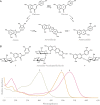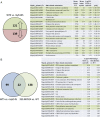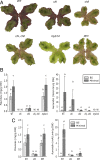Auronidins are a previously unreported class of flavonoid pigments that challenges when anthocyanin biosynthesis evolved in plants
- PMID: 31527265
- PMCID: PMC6778211
- DOI: 10.1073/pnas.1912741116
Auronidins are a previously unreported class of flavonoid pigments that challenges when anthocyanin biosynthesis evolved in plants
Abstract
Anthocyanins are key pigments of plants, providing color to flowers, fruit, and foliage and helping to counter the harmful effects of environmental stresses. It is generally assumed that anthocyanin biosynthesis arose during the evolutionary transition of plants from aquatic to land environments. Liverworts, which may be the closest living relatives to the first land plants, have been reported to produce red cell wall-bound riccionidin pigments in response to stresses such as UV-B light, drought, and nutrient deprivation, and these have been proposed to correspond to the first anthocyanidins present in early land plant ancestors. Taking advantage of the liverwort model species Marchantia polymorpha, we show that the red pigments of Marchantia are formed by a phenylpropanoid biosynthetic branch distinct from that leading to anthocyanins. They constitute a previously unreported flavonoid class, for which we propose the name "auronidin," with similar colors as anthocyanin but different chemistry, including strong fluorescence. Auronidins might contribute to the remarkable ability of liverworts to survive in extreme environments on land, and their discovery calls into question the possible pigment status of the first land plants.
Keywords: CRISPR; Marchantia; anthocyanin; flavonoid; liverwort.
Conflict of interest statement
The authors declare no conflict of interest.
Figures





Similar articles
-
The auronidin flavonoid pigments of the liverwort Marchantia polymorpha form polymers that modify cell wall properties.Plant J. 2024 Nov;120(3):1159-1175. doi: 10.1111/tpj.17045. Epub 2024 Sep 27. Plant J. 2024. PMID: 39331793
-
Evolution and function of red pigmentation in land plants.Ann Bot. 2022 Nov 17;130(5):613-636. doi: 10.1093/aob/mcac109. Ann Bot. 2022. PMID: 36070407 Free PMC article. Review.
-
Genetic analysis of the liverwort Marchantia polymorpha reveals that R2R3MYB activation of flavonoid production in response to abiotic stress is an ancient character in land plants.New Phytol. 2018 Apr;218(2):554-566. doi: 10.1111/nph.15002. Epub 2018 Jan 24. New Phytol. 2018. PMID: 29363139
-
Chemical and biological study of flavonoid-related plant pigment: current findings and beyond.Biosci Biotechnol Biochem. 2024 Jun 21;88(7):705-718. doi: 10.1093/bbb/zbae048. Biosci Biotechnol Biochem. 2024. PMID: 38632052 Review.
-
Phylogenomics reveals convergent evolution of red-violet coloration in land plants and the origins of the anthocyanin biosynthetic pathway.Mol Phylogenet Evol. 2020 Oct;151:106904. doi: 10.1016/j.ympev.2020.106904. Epub 2020 Jul 6. Mol Phylogenet Evol. 2020. PMID: 32645485
Cited by
-
Co-option of plant gene regulatory network in nutrient responses during terrestrialization.Nat Plants. 2024 Dec;10(12):1955-1968. doi: 10.1038/s41477-024-01851-4. Epub 2024 Nov 26. Nat Plants. 2024. PMID: 39592744
-
Accessible versatility underpins the deep evolution of plant specialized metabolism.Phytochem Rev. 2025;24(1):13-26. doi: 10.1007/s11101-023-09863-2. Epub 2023 Mar 30. Phytochem Rev. 2025. PMID: 39991433 Free PMC article. Review.
-
Evolution of Flavylium-Based Color Systems in Plants: What Physical Chemistry Can Tell Us.Int J Mol Sci. 2021 Apr 7;22(8):3833. doi: 10.3390/ijms22083833. Int J Mol Sci. 2021. PMID: 33917158 Free PMC article.
-
Petunia dihydroflavonol 4-reductase is only a few amino acids away from producing orange pelargonidin-based anthocyanins.Front Plant Sci. 2023 Aug 14;14:1227219. doi: 10.3389/fpls.2023.1227219. eCollection 2023. Front Plant Sci. 2023. PMID: 37645465 Free PMC article.
-
Bryo-Activities: A Review on How Bryophytes Are Contributing to the Arsenal of Natural Bioactive Compounds against Fungi.Plants (Basel). 2021 Jan 21;10(2):203. doi: 10.3390/plants10020203. Plants (Basel). 2021. PMID: 33494524 Free PMC article. Review.
References
-
- Björn L. O., Widell S., Wang T., Evolution of UV-B regulation and protection in plants. Adv. Space Res. 30, 1557–1562 (2002). - PubMed
-
- Davies K., Albert N., Zhou Y., Schwinn K., Functions of flavonoid and betalain pigments in abiotic stress tolerance in plants. Annu. Plant Rev. 1, 1–41 (2018).
-
- Landi M., Tattini M., Gould K. S., Multiple functional roles of anthocyanins in plant-environment interactions. Environ. Exp. Bot. 119, 4–17 (2015).
-
- Weng J. K., The evolutionary paths towards complexity: A metabolic perspective. New Phytol. 201, 1141–1149 (2014). - PubMed
Publication types
MeSH terms
Substances
LinkOut - more resources
Full Text Sources

